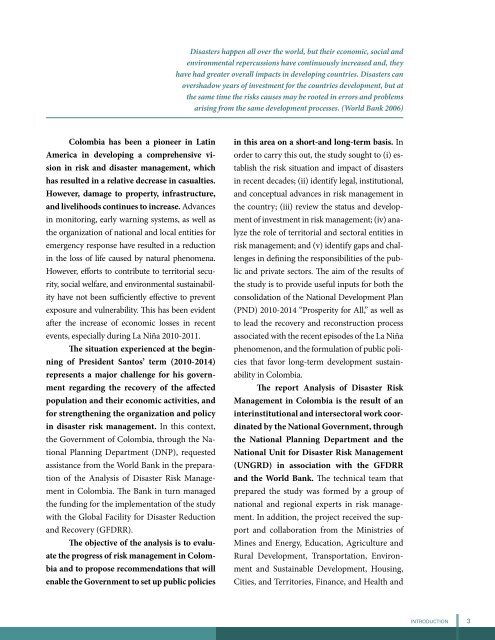Executive Summary - GFDRR
Executive Summary - GFDRR
Executive Summary - GFDRR
Create successful ePaper yourself
Turn your PDF publications into a flip-book with our unique Google optimized e-Paper software.
Disasters happen all over the world, but their economic, social and<br />
environmental repercussions have continuously increased and, they<br />
have had greater overall impacts in developing countries. Disasters can<br />
overshadow years of investment for the countries development, but at<br />
the same time the risks causes may be rooted in errors and problems<br />
arising from the same development processes. (World Bank 2006)<br />
Colombia has been a pioneer in Latin<br />
America in developing a comprehensive vision<br />
in risk and disaster management, which<br />
has resulted in a relative decrease in casualties.<br />
However, damage to property, infrastructure,<br />
and livelihoods continues to increase. Advances<br />
in monitoring, early warning systems, as well as<br />
the organization of national and local entities for<br />
emergency response have resulted in a reduction<br />
in the loss of life caused by natural phenomena.<br />
However, efforts to contribute to territorial security,<br />
social welfare, and environmental sustainability<br />
have not been sufficiently effective to prevent<br />
exposure and vulnerability. This has been evident<br />
after the increase of economic losses in recent<br />
events, especially during La Niña 2010-2011.<br />
The situation experienced at the beginning<br />
of President Santos’ term (2010-2014)<br />
represents a major challenge for his government<br />
regarding the recovery of the affected<br />
population and their economic activities, and<br />
for strengthening the organization and policy<br />
in disaster risk management. In this context,<br />
the Government of Colombia, through the National<br />
Planning Department (DNP), requested<br />
assistance from the World Bank in the preparation<br />
of the Analysis of Disaster Risk Management<br />
in Colombia. The Bank in turn managed<br />
the funding for the implementation of the study<br />
with the Global Facility for Disaster Reduction<br />
and Recovery (<strong>GFDRR</strong>).<br />
The objective of the analysis is to evaluate<br />
the progress of risk management in Colombia<br />
and to propose recommendations that will<br />
enable the Government to set up public policies<br />
in this area on a short-and long-term basis. In<br />
order to carry this out, the study sought to (i) establish<br />
the risk situation and impact of disasters<br />
in recent decades; (ii) identify legal, institutional,<br />
and conceptual advances in risk management in<br />
the country; (iii) review the status and development<br />
of investment in risk management; (iv) analyze<br />
the role of territorial and sectoral entities in<br />
risk management; and (v) identify gaps and challenges<br />
in defining the responsibilities of the public<br />
and private sectors. The aim of the results of<br />
the study is to provide useful inputs for both the<br />
consolidation of the National Development Plan<br />
(PND) 2010-2014 “Prosperity for All,” as well as<br />
to lead the recovery and reconstruction process<br />
associated with the recent episodes of the La Niña<br />
phenomenon, and the formulation of public policies<br />
that favor long-term development sustainability<br />
in Colombia.<br />
The report Analysis of Disaster Risk<br />
Management in Colombia is the result of an<br />
interinstitutional and intersectoral work coordinated<br />
by the National Government, through<br />
the National Planning Department and the<br />
National Unit for Disaster Risk Management<br />
(UNGRD) in association with the <strong>GFDRR</strong><br />
and the World Bank. The technical team that<br />
prepared the study was formed by a group of<br />
national and regional experts in risk management.<br />
In addition, the project received the support<br />
and collaboration from the Ministries of<br />
Mines and Energy, Education, Agriculture and<br />
Rural Development, Transportation, Environment<br />
and Sustainable Development, Housing,<br />
Cities, and Territories, Finance, and Health and<br />
Introduction 3

















